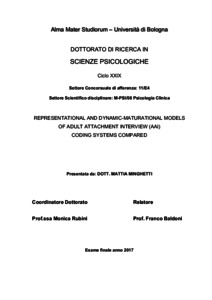Minghetti, Mattia
(2017)
Representational and Dynamic-Maturational Models of Adult Attachment Interview (AAI) Coding Systems Compared, [Dissertation thesis], Alma Mater Studiorum Università di Bologna.
Dottorato di ricerca in
Scienze psicologiche, 29 Ciclo. DOI 10.6092/unibo/amsdottorato/7981.
Documenti full-text disponibili:
![[img]](http://amsdottorato.unibo.it/7981/1.hassmallThumbnailVersion/Tesi%20Dottorato%20con%20frontespizo.pdf)  Anteprima |
|
Documento PDF (English)
- Richiede un lettore di PDF come Xpdf o Adobe Acrobat Reader
Disponibile con Licenza: Salvo eventuali più ampie autorizzazioni dell'autore, la tesi può essere liberamente consultata e può essere effettuato il salvataggio e la stampa di una copia per fini strettamente personali di studio, di ricerca e di insegnamento, con espresso divieto di qualunque utilizzo direttamente o indirettamente commerciale. Ogni altro diritto sul materiale è riservato.
Download (3MB)
| Anteprima
|
Abstract
The more valid instrument to assess adult attachment is the Adult Attachment Interview (AAI). The most famous model of AAI coding system is the M&G model, developed by Mary Main; an alternative model is based on the Dynamic-Maturational Model (DMM), proposed by Patricia M. Crittenden. Both models have strengths and weaknesses: the M&G method loses much of its capacity to discriminate clinical population, because most of the subjects in the clinical samples fall into the Unresolved/Disorganized (U/d) and/or Cannot Classified (CC) patterns, which become a sort of garbage categories for most of mental health problems (Iyengar et al., 2014). The DMM considers specific patterns, which allow better discrimination of mental health problems.
In this study, we administered the AAI to 90 Italian parents (45 males - M=35.77, SD =5.85), and we classified the interviews according to both M&G criteria and DMM criteria. We found that the two coding systems were significantly associated between them and generated sufficiently convergent results only when organized and normative attachment representations/strategies were displayed by participants. When the interviews resulted in U/d or CC (M&G) or non-normative (DMM) attachment classifications, the results of the two coding systems were not comparable. The M&G and DMM systems present deep differences in their theoretical assumptions: the M&G model refers more to discourse patterns to identify mental representations of attachment while the DMM model is more focused on the function of the attachment strategy and on the different use of cognitive and affective information, along a continuum from the use of cognitive information to the use of affective information. The findings of this study have clear implications for the use of AAI in research and clinical contexts, as they suggest that the M&G and DMM classification systems tap different features of attachment when atypical profiles are observed.
Abstract
The more valid instrument to assess adult attachment is the Adult Attachment Interview (AAI). The most famous model of AAI coding system is the M&G model, developed by Mary Main; an alternative model is based on the Dynamic-Maturational Model (DMM), proposed by Patricia M. Crittenden. Both models have strengths and weaknesses: the M&G method loses much of its capacity to discriminate clinical population, because most of the subjects in the clinical samples fall into the Unresolved/Disorganized (U/d) and/or Cannot Classified (CC) patterns, which become a sort of garbage categories for most of mental health problems (Iyengar et al., 2014). The DMM considers specific patterns, which allow better discrimination of mental health problems.
In this study, we administered the AAI to 90 Italian parents (45 males - M=35.77, SD =5.85), and we classified the interviews according to both M&G criteria and DMM criteria. We found that the two coding systems were significantly associated between them and generated sufficiently convergent results only when organized and normative attachment representations/strategies were displayed by participants. When the interviews resulted in U/d or CC (M&G) or non-normative (DMM) attachment classifications, the results of the two coding systems were not comparable. The M&G and DMM systems present deep differences in their theoretical assumptions: the M&G model refers more to discourse patterns to identify mental representations of attachment while the DMM model is more focused on the function of the attachment strategy and on the different use of cognitive and affective information, along a continuum from the use of cognitive information to the use of affective information. The findings of this study have clear implications for the use of AAI in research and clinical contexts, as they suggest that the M&G and DMM classification systems tap different features of attachment when atypical profiles are observed.
Tipologia del documento
Tesi di dottorato
Autore
Minghetti, Mattia
Supervisore
Dottorato di ricerca
Ciclo
29
Coordinatore
Settore disciplinare
Settore concorsuale
Parole chiave
Attachment, Adult Attachment Interview, AAI, Main & Goldwyn model, Dynamic Maturational Model.
URN:NBN
DOI
10.6092/unibo/amsdottorato/7981
Data di discussione
11 Maggio 2017
URI
Altri metadati
Tipologia del documento
Tesi di dottorato
Autore
Minghetti, Mattia
Supervisore
Dottorato di ricerca
Ciclo
29
Coordinatore
Settore disciplinare
Settore concorsuale
Parole chiave
Attachment, Adult Attachment Interview, AAI, Main & Goldwyn model, Dynamic Maturational Model.
URN:NBN
DOI
10.6092/unibo/amsdottorato/7981
Data di discussione
11 Maggio 2017
URI
Statistica sui download
Gestione del documento:


 Login
Login
